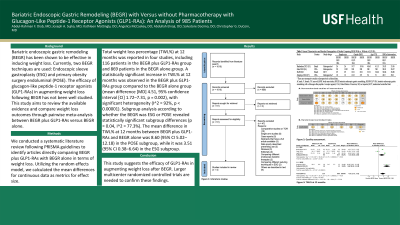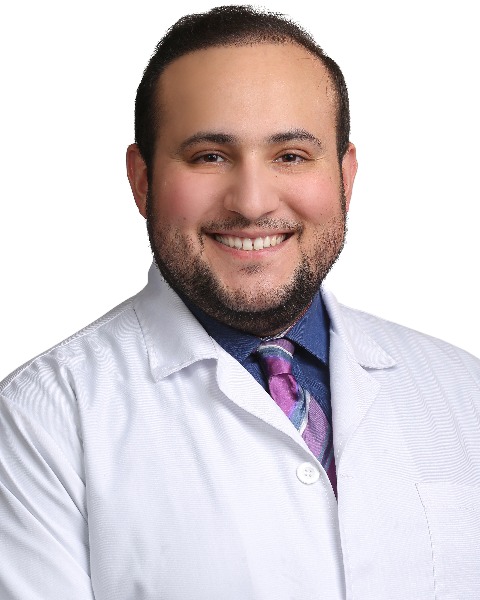Sunday Poster Session
Category: Interventional Endoscopy
P1026 - Bariatric Endoscopic Gastric Remodeling (BEGR) With Versus Without Pharmacotherapy With Glucagon-Like Peptide-1 Receptor Agonists (GLP1-RAs): An Analysis of 985 Patients
Sunday, October 27, 2024
3:30 PM - 7:00 PM ET
Location: Exhibit Hall E

Has Audio

Abdul-Rahman F. Diab, MD
University of South Florida Morsani College of Medicine and University of Central Florida, HCA Healthcare GME
Ocala, FL
Presenting Author(s)
Abdul-Rahman F. Diab, MD1, Joseph A. Sujka, MD2, Kathleen Mattingly, DO3, Angelica McCaskey, DO3, Abdullah Elnaji, DO3, Salvatore Docimo, DO2, Christopher G. DuCoin, MD2
1University of South Florida Morsani College of Medicine and University of Central Florida, HCA Healthcare GME, Ocala, FL; 2University of South Florida Morsani College of Medicine, Tampa, FL; 3University of Central Florida, HCA Healthcare GME, Ocala, FL
Introduction: Bariatric endoscopic gastric remodeling (BEGR) has been shown to be effective in inducing weight loss. Currently, two BEGR techniques are used: Endoscopic sleeve gastroplasty (ESG) and primary obesity surgery endoluminal (POSE). The efficacy of glucagon-like peptide-1 receptor agonists (GLP1-RAs) in augmenting weight loss following BEGR has not been well studied. This study aims to review the available evidence and compare weight loss outcomes through pairwise meta-analysis between BEGR plus GLP1-RAs versus BEGR alone.
Methods: We conducted a systematic literature review following PRISMA guidelines to identify articles directly comparing BEGR plus GLP1-RAs with BEGR alone in terms of weight loss. We utilized the random effects model and calculated mean differences for continuous data as metrics of effect size.
Results: Total weight loss percentage (TWL%) at 12 months was reported in four studies, including 116 patients in the BEGR plus GLP1-RAs group and 869 patients in the BEGR alone group. A statistically significant increase in TWL% at 12 months was observed in the BEGR plus GLP1-RAs group compared to the BEGR alone group (mean difference [MD] 4.51, 95% confidence interval [CI] 1.72–7.31, p = 0.002), with significant heterogeneity (I^2 = 92%, p < 0.00001). Subgroup analysis according to whether the BEGR was ESG or POSE revealed statistically significant subgroup differences (p = 0.04, I^2 = 77.3%). The mean difference in TWL% at 12 months between BEGR plus GLP1-RAs and BEGR alone was 8.60 (95% CI 5.02–12.18) in the POSE subgroup, while it was 3.51 (95% CI 0.38–6.64) in the ESG subgroup.
Discussion: This study suggests the efficacy of GLP1-RAs in augmenting weight loss after BEGR. Larger multicenter randomized controlled trials are needed to confirm these findings.

Disclosures:
Abdul-Rahman F. Diab, MD1, Joseph A. Sujka, MD2, Kathleen Mattingly, DO3, Angelica McCaskey, DO3, Abdullah Elnaji, DO3, Salvatore Docimo, DO2, Christopher G. DuCoin, MD2. P1026 - Bariatric Endoscopic Gastric Remodeling (BEGR) With Versus Without Pharmacotherapy With Glucagon-Like Peptide-1 Receptor Agonists (GLP1-RAs): An Analysis of 985 Patients, ACG 2024 Annual Scientific Meeting Abstracts. Philadelphia, PA: American College of Gastroenterology.
1University of South Florida Morsani College of Medicine and University of Central Florida, HCA Healthcare GME, Ocala, FL; 2University of South Florida Morsani College of Medicine, Tampa, FL; 3University of Central Florida, HCA Healthcare GME, Ocala, FL
Introduction: Bariatric endoscopic gastric remodeling (BEGR) has been shown to be effective in inducing weight loss. Currently, two BEGR techniques are used: Endoscopic sleeve gastroplasty (ESG) and primary obesity surgery endoluminal (POSE). The efficacy of glucagon-like peptide-1 receptor agonists (GLP1-RAs) in augmenting weight loss following BEGR has not been well studied. This study aims to review the available evidence and compare weight loss outcomes through pairwise meta-analysis between BEGR plus GLP1-RAs versus BEGR alone.
Methods: We conducted a systematic literature review following PRISMA guidelines to identify articles directly comparing BEGR plus GLP1-RAs with BEGR alone in terms of weight loss. We utilized the random effects model and calculated mean differences for continuous data as metrics of effect size.
Results: Total weight loss percentage (TWL%) at 12 months was reported in four studies, including 116 patients in the BEGR plus GLP1-RAs group and 869 patients in the BEGR alone group. A statistically significant increase in TWL% at 12 months was observed in the BEGR plus GLP1-RAs group compared to the BEGR alone group (mean difference [MD] 4.51, 95% confidence interval [CI] 1.72–7.31, p = 0.002), with significant heterogeneity (I^2 = 92%, p < 0.00001). Subgroup analysis according to whether the BEGR was ESG or POSE revealed statistically significant subgroup differences (p = 0.04, I^2 = 77.3%). The mean difference in TWL% at 12 months between BEGR plus GLP1-RAs and BEGR alone was 8.60 (95% CI 5.02–12.18) in the POSE subgroup, while it was 3.51 (95% CI 0.38–6.64) in the ESG subgroup.
Discussion: This study suggests the efficacy of GLP1-RAs in augmenting weight loss after BEGR. Larger multicenter randomized controlled trials are needed to confirm these findings.

Figure: Forest plot comparing the BEGR plus GLP1-RAs group versus the BEGR alone group in total weight loss percentage at 12 months, with subgroup analysis according to the BEGR procedure (ESG vs. POSE).
BEGR; Bariatric Endoscopic Gastric Remodeling, GLP1-RAs; Glucagon-Like Peptide-1 Receptor Agonists, ESG; endoscopic sleeve gastroplasty, POSE; primary obesity surgery endoluminal.
BEGR; Bariatric Endoscopic Gastric Remodeling, GLP1-RAs; Glucagon-Like Peptide-1 Receptor Agonists, ESG; endoscopic sleeve gastroplasty, POSE; primary obesity surgery endoluminal.
Disclosures:
Abdul-Rahman Diab indicated no relevant financial relationships.
Joseph Sujka indicated no relevant financial relationships.
Kathleen Mattingly indicated no relevant financial relationships.
Angelica McCaskey indicated no relevant financial relationships.
Abdullah Elnaji indicated no relevant financial relationships.
Salvatore Docimo indicated no relevant financial relationships.
Christopher DuCoin indicated no relevant financial relationships.
Abdul-Rahman F. Diab, MD1, Joseph A. Sujka, MD2, Kathleen Mattingly, DO3, Angelica McCaskey, DO3, Abdullah Elnaji, DO3, Salvatore Docimo, DO2, Christopher G. DuCoin, MD2. P1026 - Bariatric Endoscopic Gastric Remodeling (BEGR) With Versus Without Pharmacotherapy With Glucagon-Like Peptide-1 Receptor Agonists (GLP1-RAs): An Analysis of 985 Patients, ACG 2024 Annual Scientific Meeting Abstracts. Philadelphia, PA: American College of Gastroenterology.
